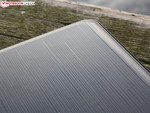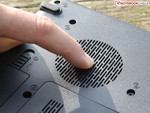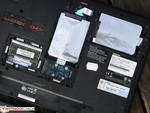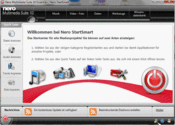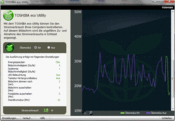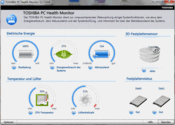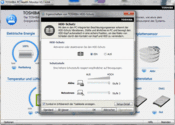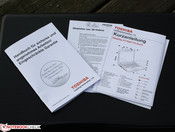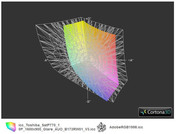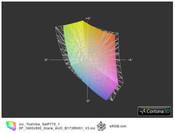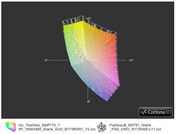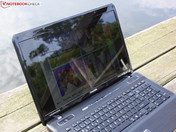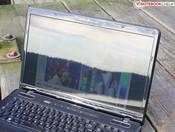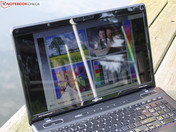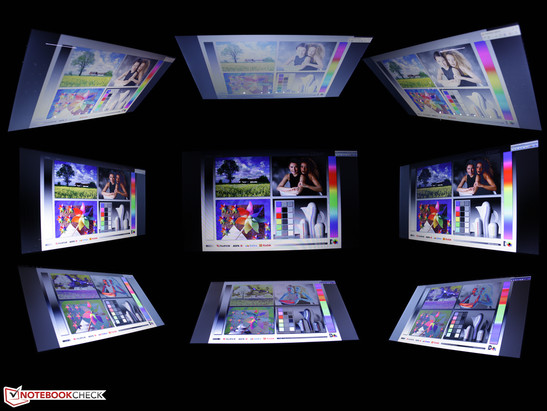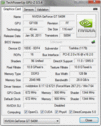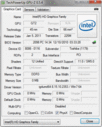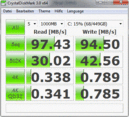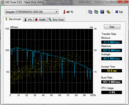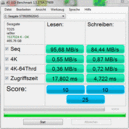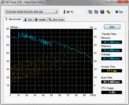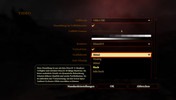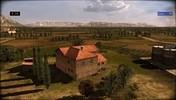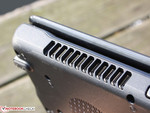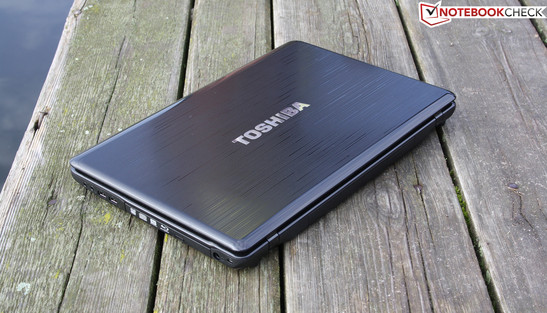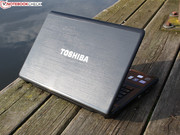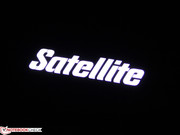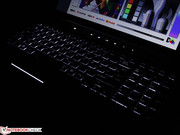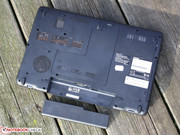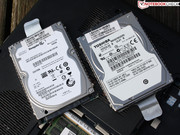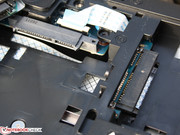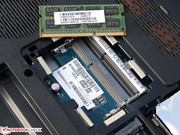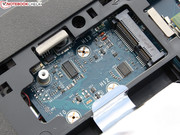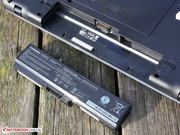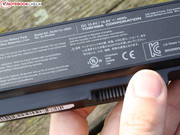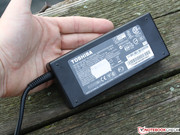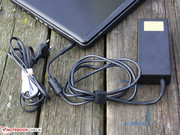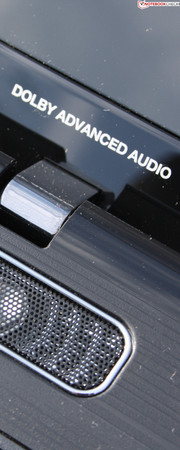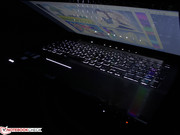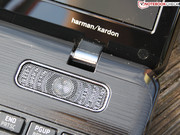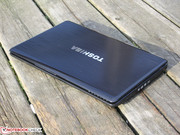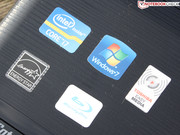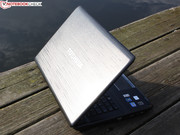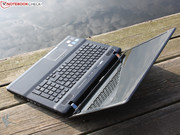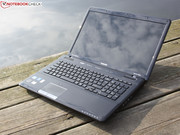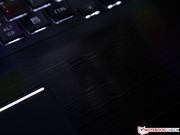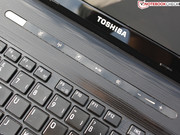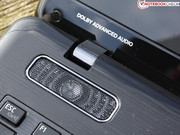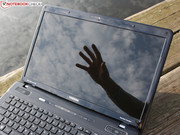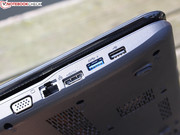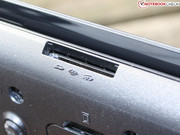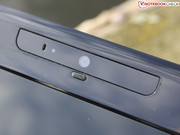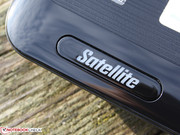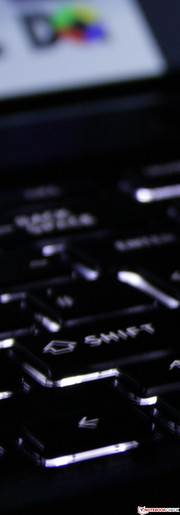Review Toshiba Satellite P770-10P Notebook

The high-end Toshiba Satellite is apparently having a hard time finding its way onto the virtual shelves. Only one single retailer currently lists it - but without immediate availability (status: 08/19/11). Yet, the technical specs don't sound that bad at all.
The Core i7-2630QM (4x 2.00GHz) is Intel's mainstream quad-core and used in many multimedia and gaming laptops. Just like the NVIDIA GeForce GT 540M graphics card which is only a midrange gaming graphics for gaming fans, though. Friends of large movie collections will be pleased about the two hard disks in the case (2 x 500 GB). The Seagate Momentus XT is equipped with a 4GB SSD cache (SLC-NAND). Thus, it is a hybrid hard disk.
The bundle allegedly has a market price of 999 euros (version P770-108: 899 euros). The 17 inch model has to bid a few advantages because the identical CPU+GPU hardware is already available for 700 euros (e. g. Samsung RC730). Find out what feats the Satellite P770-10P has to offer in our comprehensive review.
Case
In terms of looks, the Satellite P770-10P emits the charm of a revamped plastic laptop that doesn't want to admit its plastic construction at any cost. Thus, the user's eye is bombarded with light effects (keys, pad, logo, media bar, power on) and deterred by excessive chrome looks (speakers, pad keys, hinges). The packaging artists' trick box was searched thoroughly for the surfaces. Where its sister model, Satellite Pro L770, cried for frills with its matt, dull surfaces, the P770's surfaces have been polished to high-gloss and been given a tactile texture. This can't hide the plastic looks, but at least the plastic feel. Nevertheless, the manufacturing has its advantages: Fingerprints disappear in the texture and the surfaces feel quite slip-proof.
Overall, the case has satisfactory but not good pressure stability. The wrist rest yields on the outer right and left under the weight of the hands. The optical drive is, as so often, a weak point. Although the number pad above it can't be depressed, the base plate below it can.
Two hinges hold the lid tight. There is no lock. The heavy screen teeters when handled. The maximum opening angle of about 140 degrees is well suited for use on the lap. The lid's surface can be depressed over a large area, but only by a few millimeters.
Connectivity
Diversity looks different. USB 3.0 on the left is the only port worth mentioning, but belongs to standard in this price range. The ExpressCard slot that would enable the user to plug in expansion cards is unfortunately not installed.
We find the port arrangement in the left and right front area annoying. If you connect HDMI, USB 3.0 (left) and two USB devices in addition to loudspeakers (right), you'll overload your desk with a cable tree on both sides. Now there is no place to put a mouse, and the cable clutter will at least look unsightly. Interfaces at the rear, like in the good old laptop days, aren't possible due to the sunken hinges.
Communication
The wireless and network connections are up to date. The Realtek PCIe GBE Family Controller (1000 Mbit/s), the Atheros wireless card AR9002WB-1NG and the Bluetooth module (3.0+HS) are all state of the art.
Supplies
Recovery DVDs for Windows 7 Home Premium (64 bit) has to be created via Recovery Media Creator by the user. Only a small manual and quick guide are included. Besides various Toshiba tools (e. g. Webcamera, face detection, HWSetup, Recovery Media Creator, Media Controller, etc.), Nero Multimedia Suite 10 Essential (backup, burning program, media hub, etc.) belong to the pre-installed software. The face recognition has long been standard with Toshiba and makes logging in via face possible.
Entertainment
Toshiba's Media Player can convert a 2D movie to 3D via HDMI and render it on a 3D TV set. The technology that enhances low definition video material to HD (e. g. a DVD movie is called Resolution+. Last but not least, there is Sleep-and-Music. The function (disable in BIOS or via HWSetup) enables the analog-in (microphone) when the PC is turned off. Then you can use the amplified laptop speakers with an MP3 player.
Warranty
The Satellite P770 is given a two year warranty. It includes a pick-up service subsequent to registration via the Toshiba hotline in Germany and Austria. The manufacturer has a warranty extension for up to 3 or 4 years in its range (64 or 109 euros).
Input Devices
Keyboard
The keys with a level surface are like square tablets lined up on a tray. Typing is a bit inaccurate without a concave depression and despite the clear pressure point and medium key drop. In return, the key bed doesn't coil. It fits tight (even above the optical drive). The keyboard has a soft and silent stop. Due to the slightly slippery, but not unpleasant keys' surface, the typing feedback is dampened and will appeal to sensitive touch typists. If you tend to hit the keys hard, you'll find the feedback unclear.
The number pad in a standard layout facilitates entering numbers. A good job has been done with the spatial separation of both areas - keyboard and number pad. Furthermore, Toshiba has thought of separated arrow keys. Incorrect inputs are minimized by the small gap to the shift key.
Touchpad
The mouse replacement (multi-touch pad, Synaptics V7.4) is a part of the wrist rest. The pad is quite big (diagonal of 10.6 cm). The field has a vertical and horizontal scroll bar - although they aren't visibly marked. The matt surface lets the finger rub audibly and feels pleasantly dry (the opposite would be greasy).
The rounded and upward curved keys have a high pressure point and click loud and muffled. The stroke is unfortunately too short and thus unsatisfactory. The noisy feedback will quickly get annoying and make you look for an external mouse. The LED indicator in the touchpad's top area shows searching fingers the way, because there is no crosspiece toward the wrist rest. It is disabled with the button above the pad and the LED is turned off.
Display
The 17.3 inch glare panel can only satisfy high expectations with its feasible brightness. Everything else is bottom of the barrel of laptop screens. The screen (AUO B173RW01 V3) has a resolution of 1600 x 900 pixels (WXGA++, 16:9). You can work well with this resolution if you don't need the best possible resolution on your screen.
The AUO panel has a low contrast of 212:1. The glare-type visibly pretties up the poor contrast. This creates a visually crisp color impression. The colors are thus fairly appealing for consuming pictures, movies or games. Nevertheless, black isn't deep black and colors aren't as bright as they could be. The AUO screen isn't suitable for pros because the color spectrum doesn't even cover sRGB (t). The FHD screen in Fujitsu's NH751 proves that even consumer screen's from the same price range can bid more (nearly sRGB, high contrast, good viewing angles).
| |||||||||||||||||||||||||
Brightness Distribution: 95 %
Center on Battery: 188 cd/m²
Contrast: 212:1 (Black: 1.03 cd/m²)55.9% AdobeRGB 1998 (Argyll 2.2.0 3D)
80.8% sRGB (Argyll 2.2.0 3D)
54% Display P3 (Argyll 2.2.0 3D)
The brightness measurement shows acceptable results. The luminance is averagely 216 cd/m2. Gossen Mavo Monitor measures up to 220 cd/m2 selectively. The illumination is at 95 percent unusually even. No light spots are visible on a completely black screen.
100 to 150 cd/m2 are sufficient for indoors. Will the brightness bonus be enough to work in daylight despite the glare-type? No, because reflections prevent an interference-free picture in most viewing angles. Our pictures were taken in sunlight and maximum TFT brightness. We have to note that the P770 reduces the brightness to 188 cd/m2 in battery mode (measured center).
We can deviate up to 50 degrees from the front view horizontally. The colors then start to falsify more or less severe. Script can be read up to 70 degrees without problems. The colors start to distort sooner at 10 degrees vertically. The image fades and the colors invert. That can already be a torture for looking at pictures or movies in twos or threes. The viewers have to put their heads close together. These viewing problems are unfortunately a common phenomenon for 80 percent of our test laptops. This is a very adverse quality for a high-priced multimedia device.
Performance
The Core i7-2630QM with 4x2.0 GHz (default clock) has been used frequently in many laptop models since the beginning of 2011. It is Intel's latest mainstream quad core which is already available in devices for starting at 700 euros. Overclocking up to 2.9 GHz is possible via Turbo Boost 2.0 when required (one core). Please see the CPU data sheet for details.
The incorporated HD Graphics 3000 ensures an economic use when battery life is or GPU performance isn't needed. The NVIDIA GeForce GT 540M (2048 MB) is automatically disabled via Nvidia Optimus. The BIOS has many options for enabling/disabling devices (LAN, webcam, touchpad, key light, illuminated Satellite logo) and for configuring Power Management. Technology fans can even disable the quad core CPU's multi core processing or Turbo Boost. However, this is not recommended because the idle power consumption is very low in its default version.
Where is the 2630QM compared to other identical CPUs in laptops? The Cinebench R11.5 test (multi, 64 bit) hits the bull's-eye, i.e. 4.7 points is the average of 2630QM test devices. The "same" i7-2630QM in the Aspire 7750G could score better with 5.0 points, which could be due to a better utilization of the Dynamic Frequency (Turbo 2.0).
Extensive rendering and conversion tasks are the right work for the processor. Power users are well served, especially since high load doesn't cause thermal throttling and turbo is exploited. Turbo even remains active when the GPU is put under highest load (Furmark). Please see Temperature and the following screenshots.
PCMark Vantage determines 6963 points (first run: 6752) which is a slightly below-average score for this CPU+GPU combination. The Sony Vaio VPC-F22S1E/B recently achieved 7488 points (also 7200 rpm HDD). An Aspire 7750G with the same processor manages 7402 points (HP 6850M). Only Packard Bell's EasyNote TS11-HR-158GE and Samsung's RF511 are defeated with 6500 points, which is due to the 5400 rpm HDD and possibly a lower Turbo 2.0 exploitation. These two laptops are equal with our test device in Cinebench R11.5: 4.7 points.
Laptops equipped with an SSD, such as the Alienware M17x R3 (GTX 460M, i7-2630QM) or the XMG A701 (identical), reach considerably betters scores (12700 / 14000). The hybrid HDD, Momentus XT, can't supply this. Please see Hard Disk.
We executed PCMark 7, which finishes with an unusually high score of 2688 points (first run: 2496). The gaming machine, MSI GT780R with a GTX 560M, recently reached a similar score (2516 points, RAID0 with 2x5400 rpm). PCMark 7 acknowledges the hybrid HDD, which we can observe in repeated execution of the System Storage test: 2068, 2419, 2479, 2528, 2576, 2494, 2597, 2613. The score increases! The reason: The hybrid HDD learns.
| PCMark Vantage Result | 6963 points | |
| PCMark 7 Score | 2688 points | |
Help | ||
The GeForce GT 540M's 3D performance (2048 MB DDR3) remains on the usual level despite a larger memory (usually 1024 MBs). The clock of 672/900 MHz (core/memory) corresponds to the standard specs.
3DMark 2006 (1280x1024) finishes with 8212 points. A current HD 6770M (10786) in the HP Pavilion dv6-6008eg can easily beat that. The 3DMark Vantage score: P4386 is also exactly on the level where most GT 540s were. The same for 3DMark 11 (P1009) that is on a par with an HD 6630M (Sony Vaio VPC-SA2Z9E/B).
| 3DMark 05 Standard | 15697 points | |
| 3DMark 06 Standard Score | 8212 points | |
| 3DMark Vantage P Result | 4386 points | |
| 3DMark 11 Performance | 1009 points | |
Help | ||
Toshiba equips the P770-10P with two hard disks. They are not connected via a RAID controller (performance or redundancy). The hybrid HDD Seagate Momentus XT (ST95005620AS, 500GB) that rotates with 7200 rpm makes the dual solution interesting. It has an unusually big 4GB SSD cache (SLC-NAND), which is continuously fed with frequently used data and files autonomously via the "adaptive memory" technology. That means, opening programs or Window files is sped up because frequently read files are automatically transferred to the flash part. Because this happens on the hardware side, the user shouldn't and mustn't worry about what files are moved to the small flash memory. Consequently, the technology is platform independent and could also speed up a Linux. Important: We are only talking about files that are repeatedly read.
Besides that, a slow Toshiba MK5076GSXN (500GB, 5400rpm) is installed. We haven't entered their throughputs in our database yet. HDTune (61 instead of 85 MB/s) is a lot lower than with the Momentus XT system hard disk.
The application performance benefits from the learning hybrid hard disk with a PCMark Vantage HDD score of 6617 points, respectively 2613 points in PCMark 7's memory test. The fastest 7200 rpm HDD in our tests had 5030 points (PCMark Vantage, no RAID0, HP ProBook 6560b-LG658EA).
Comparison rates: Two Momentus XT (no RAID0) work inside the Asus G73SM, which lifts the score to 8096 points. One Momentus XT is enough for 8046 points in the Eurocom Racer. It's a RAID 0 array, made up of 2 x 7200 rpm, that only achieves 5193 points in the MSI GT663R.
On the other hand, it's fact that a pro SSD, like the Intel 320 Series SSDSA2CW160G3 (160GB) in Schenker's XMG A501, achieves 39530 points. Even a simple consumer SSD, as in the Acer Aspire 4820TG (Intel X25-M, 160 GBs), manages 20196 points. In short: The hybrid HDD is an advantage but not a big hit in the SSD comparison.
We only tried out how games behave with the GT 540M in random tests because comprehensive tests have already been made with this GPU. Please see the GT 540M's data sheet.
Dirt 3
The race game has a built-in benchmark for an exactly repeatable measurement. Good frame rates are achieved in 1360x768 pixels and high details: 38 fps. Gamers shouldn't switch to the native WXGA++ because 13 fps aren't playable (Ultra details, 4AA). The quad CPU isn't mandatory for Dirt 3. Even an MSI GE620 (i5-2410M) delivers 38 fps in high details.
| Dirt 3 | |||
| Resolution | Settings | Value | |
| 1360x768 | High Preset, 2xAA, -AF | 38 fps | |
| 1024x768 | Medium Preset, 0xAA, -AF | 61 fps | |
RUSE
The real-time strategy game runs satisfactorily. However, gamers shouldn't even think about WXGA++. The frames drop to 10.5 fps in ultra details. It looks better in high details (1366x768, 4AA). The demo's mission plays with an average of 22 fps in the first few minutes. RUSE accomplishes better 34 fps in medium details, again with 1366x768 pixels and reduced antialiasing (2AA).
Dragon Age 2
The battle game requires strong hardware and thus only 18 fps are possible in 1366x768 and high details (2AA, DX11). The game is first smooth in medium details (0AA, DX11) in the same resolution: 36 fps.
Gaming Verdict
The random tests confirm the test device's satisfactory gaming performance. Smooth game play is granted as long as the gamer does not switch to the native 1600x900 pixels. The GT 540M is too weak for high details beyond WXGA. A HD 6770M (HP Pavilion dv7-6101eg, Dirt 3 high 46fps), a GT 555M (Medion Erazer X6815) or a GTX 560M (MSI GT780R, Dirt 3 high 85fps) would be the better choice for gamers nowadays.
| low | med. | high | ultra | |
| Dirt 3 (2011) | 61 | 38 |
Emissions
System Noise
Everyone who accepted a loud fan 10 years ago knows that there are ultra silent laptops available today. Roaring fans don't have to be accepted any longer. The P770 doesn't show any irregularities in this respect. The fan even turns itself off in long idle periods / after a cold start. The 7200 rpm hard disk's quiet noise defines the low level with 31.8 dB (A).
The fan doesn't turn off, but always remains audible in activity, so surfing and emailing, with 35 to 37 dB (A). Since the speed does not change abruptly, but slowly, changes are hardly noticed.
The fan turns up to 44 dB (A) in games, respectively 3D benchmarks. The noise is low 41.1 dB (A) in the unrealistic stress test, where the CPU's eight threads are put under maximum load (Prime95) and the GeForce GT 540M calculates on all shaders (Furmark). That is surprising at first glance, but can be explained by the reduction of the turbo clock to its default clock (2.0 GHz).
Noise Level
| Idle |
| 31.8 / 34.8 / 35.4 dB(A) |
| HDD |
| 33.6 dB(A) |
| DVD |
| 37 / dB(A) |
| Load |
| 41.1 / 44 dB(A) |
 | ||
30 dB silent 40 dB(A) audible 50 dB(A) loud |
||
min: | ||
Temperature
The P770 behaves positively in terms of waste heat in idle or simple office use and at best reaches over 30 degrees selectively. The bottom's average temperature is only 28 degrees in idle. The wrist rest also stays cool with 28 degrees.
The waste heat's peaks are a lot higher in the stress test: We measure 52 degrees Celsius in the vent's vicinity on the bottom. Nevertheless, the average is only 38 degrees because these high temperatures are only measured selectively in the fan's area. The wrist rest heats up to 40 degrees during the stress test. The adapter reaches up to 45.6 degrees when the maximum effective power of 92 watts is applied. That's not yet overheating.
No Throttling
The multimeter indicates that the computer has a constant power consumption of 91.5 watts during the stress test comprised of Prime95 and Furmark (CPU @2.0 GHz, default clock, no throttling). The additional GPU load causes a reduction up to deactivation of the turbo clock, but the default rage is always maintained (test period: 5 hours).
(-) The maximum temperature on the upper side is 45.7 °C / 114 F, compared to the average of 36.9 °C / 98 F, ranging from 21.1 to 71 °C for the class Multimedia.
(-) The bottom heats up to a maximum of 52.4 °C / 126 F, compared to the average of 39.1 °C / 102 F
(+) In idle usage, the average temperature for the upper side is 26.7 °C / 80 F, compared to the device average of 31.2 °C / 88 F.
(-) The palmrests and touchpad can get very hot to the touch with a maximum of 40.1 °C / 104.2 F.
(-) The average temperature of the palmrest area of similar devices was 28.8 °C / 83.8 F (-11.3 °C / -20.4 F).
Speakers
Both Harman/Kardon speakers really put a step on it - even without subwoofer support. The sound is loud, clear (highest volume) and balanced. The trebles in classical music are rendered just as well as the deep basses in rock music. Although we aren't facing a bass miracle, the vibration is perceptible. The surround sound is very pleasant for a laptop and invites to listening to loud music.
The volume can easily be controlled via the soft touch bar (+ mute button). Merely the beep is annoying when the button is tapped. The Dolby Audio Enhancer is very effective in the P770 (speaker properties). It enhances the trebles and extends the bass range by one octave. Loudspeakers or headphones can only be connected analog via the jack.
Battery Life
The Satellite P770's power consumption is low when the processor and/or graphics aren't put under load. The power requirement is 11.7 watts (idle, min) when all energy saving options are set in idle (minimum TFT brightness, wireless off). However, a bright display, enabled wireless modules and high performance mode consume 24 watts (idle, max).
The maximum power consumption (without battery charging) is 92 watts (Prime95 & Furmark). The 120 watt power adapter (616 grams) is adequately designed. Sole CPU load (Prime95) requires 80 watts in the first few minutes (@ 2.6 GHz turbo) to settle to 62 watts (@ 2.0 GHz). This shows us the Turbo Boost 2.0's activity.
| Off / Standby | |
| Idle | |
| Load |
|
The inserted lithium ion battery (48 Wh) is fully recharged after a charging time of about 1:45 hours and ready for our battery tests. We determined 3:33 hours in WLAN surfing. In view of the battery's comparatively low capacity, this runtime is acceptable for a 17.3 incher with a dedicated graphics card. The DVD test isn't quite as long. The movie Lord of the Rings comes to its end after 2:51 hours (brightness @100 cd/m2, wireless off). The battery life looks totally different during processor load. It's drained after only 49 minutes.
Verdict
The Toshiba Satellite P770-10P is a 17.3 inch laptop with strengths in performance (CPU, HDD), power consumption and sound. However, many weaknesses line up right behind and prevent a rating over 80%.
If you are anxiously looking for a quad core notebook without CPU throttling, you'll find one in the Satellite P770-10P. The Core i7-2630QM, together with the hybrid hard disk (4GB SLC-NAND), ensures a high application performance. The Seagate system disk provides unusually high read rates in files that are repeatedly read (system start, opening programs) for a rotating HDD. The conventional 500 GB Toshiba HDD is a pure memory capacity supplier that is installed as a second memory.
The power consumption in idle is very low (12-24 watts) and the 120 watt power adapter has enough capacity for the stress power requirement of 92 watts. The Harman/Kardon speakers emit a balanced sound even without a subwoofer that can even reproduce a fraction of bass. The configuration with BluRay reader and USB 3.0 fits to a multimedia device. However, we would have really appreciated an ExpressCard slot for expansion cards.
The WXGA++ glare-type screen (1600x900) is disappointing due to its low contrast and narrow viewing angles. The noise is acceptable during high load (stress, games), but unfortunately it's also always audible in idle and stress-free office mode. The waste heat can heat up the keyboard to 45 degrees during load.
The case is manufactured sufficiently stiff for a 1000 euro laptop, but many buyers expect an aluminum finish and not plastic with pimped surfaces for this price.
There are a lot of less expensive alternatives when looking for a 17 inch quad notebook with a fairly gaming suitable GT 540M graphics and an i7-2630QM. The Samsung RC730 (NP-RC730-S05DE) is the deal at currently 680 euros. If you put value on screen quality, you should take a look at Fujitsu's Lifebook NH751 (FHD, high contrast, starts at 925 euros).


 Deutsch
Deutsch English
English Español
Español Français
Français Italiano
Italiano Nederlands
Nederlands Polski
Polski Português
Português Русский
Русский Türkçe
Türkçe Svenska
Svenska Chinese
Chinese Magyar
Magyar